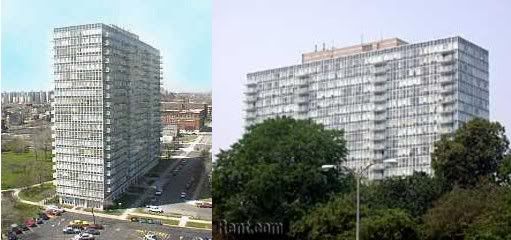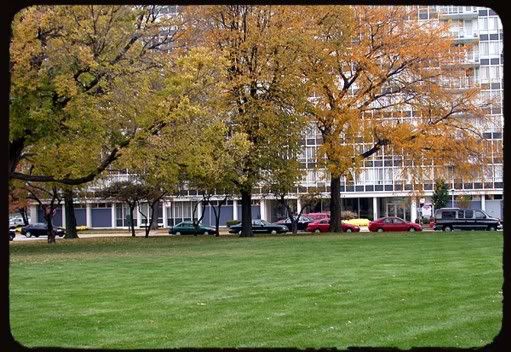Whether the ancient protection of English common law of the rights of private property against incursions by the State shall be wholly abandoned is a question which probably will have to be left to history since we seem to be well on our way.The Supreme Court Tuesday heard arguments on the constitutionality of a municipality using "eminant domain" to seize property from one group of private owners and transfer it to another. At issue is a plan by the government of New London, Connecticut to seize the homes of seven families in the Fort Trumbull neighborhood, demolish the homes and re-sell the land to private developers.
-L.D. McKendry, vice-president, Chicago Title and Trust Company,
to Holman D. Pettibone, November 9,1948, Holman D. Pettibone Papers,
Chicago Historical Society
The constitution gives states and municipalities the right to take private land for public use as long as just compensation is given. At issue is whether governments can take land for private use. The city of New London is arguing that this is a legitimate use of government power because the new development would produce more tax revenue for the city. The residents argue that this argument is nonsense. "Every city has problems, every city would like more tax revenue," said Scott Bullock, the attorney for the families who are suing to keep their land. "But that cannot be justification ... for the use of eminent domain." Doing so would put everyone's home at risk of being torn down for a property-tax producing Wal Mart or Home Depot.
To understand the implications of the case, we should look at how this practice began, over fifty years ago, here in Chicago. The practice began in an attempt by powerful Loop interests to deal with perceived threats to their investments posed by the decline of the central city and the departure of the middle class to the suburbs. For details I refer to Arnold Hirch's excellent book, Making the Second Ghetto, which describes the creation of Chicago's segregated black ghettoes, of both the slum and public housing varieties, in the immediate post-War period.
Not only did the burgeoning suburbs attract much of the Loops' clientele, but the subsequent decay of the inner city placed severe financial burdens on the city and, especially, its large businesses. Slums meant increased costs for police and fire protection and decreased revenues resulting from tax delinquencies. Should the physical deterioration of hte central districts continue, immobile businesses and institutions would have to pay increased taxes to offset the city's rising costs and shrinking income. It was necessary to "restore deteriorated areas to profitable uses: so that "the speedign up of decentralization with further loss of jobs, bussinesses, families and tax revenues" could be halted.
Sound familiar? These gentlemen of note convinced Mayor Kennelly and Governor Green to push for passage of the Blighted Areas Redevelopment Act of 1947, which allowed municipalities to create bodies - such as the Chicago Land Clearance Commission, which could seize property using eminant domain for the purpose of selling this property to private developers for large scale redevelopment projects. Many Republicans who remained steadfastly opposed to public housing found they were much more comfortable with the private sector "taking the lead" in redevelopment.
A willing developer was quickly found for the targeted Near South Side neighborhood - the New York Life Insurance Company. New York Life planned to buy a huge swath of land just south of the Loop to build a series of huge Modernist highrise apartment buildings in "superblock," surrounded by parking lots and private green space, provided the city would seize and clear the land, and close and tear up the existing grid of city streets in the neighborhood.
Once the private developer became involved, however, it quickly began making large demands on the city government in exchange for funding the project. A new school and park were demanded, and Cottage Grove Ave. would have to be closed at 33rd Place. And while the project was initially conceived as a way to remove deteriorating "slum" housing, New York LIfe insisted on shifting the project site east, where it bordered on the railroad tracks which run parallel to Lake Shore Drive - in order to secure the lake views which would attract middle class residents, in spite of the fact that these easternmost properties were in fact well maintained did not fit the definition of "slum housing" or "blighted area," unless those terms are to be interpreted simply as code for "black people."
So a project originally intended to produce tax revenue and customers for downtown merchants by replacing degraded housing quickly became a way for a private corporation to co-opt government power to seize property from other private owners, who did not particularly want to sell, for their own private gain. And what happened to the less well off residents of the existing neighborhood?
In relocating the residents of the Dearborn Homes site, the [Metropolitan Housing and Planning Council] noted that in "many cases" it had been "necessary to break up the family in order to place them in any kind of home" . . . A family consisting of a grandmother, mother, and four children, unable to relocate themselves, followed a CLCC suggestion that the grandmother leave the family to permit the others to qualify for Aid to Dependent Children and public housing. Two months after the grandmother left, her daugher and the chidren were placed on ADC and in the Dearborn Homes.Helped on their way to welfare dependency and the projects - another great victory for Progress! All to make way for the majestic glory that was Lake Meadows. Although today few sane people will defend them aesthetically, they have been held up by some as a model of middle-class integration in a segregated era (for years a "racial balance" was achieved by discriminating against black applicants to keep the population about 45% white in spite of a preponderance of blacks in the applicant pool. The pros and cons of such a policy in such a time are debatable - today such practices are quite illegal).


Most Chicagoans today are familiar with the overwhelming blandness of the looming highrises, which echo the (subsequently built and recently demolished) State Street Corridor public housing highrises they presaged. The complex still serves the same purpose - providing middle-class housing close to the Loop. The loons who write about architecture and real estate at the Tribune seem to like the place. Contemporary tenant reviews of Lake Meadows are mixed. Recent development in the neighborhood seeks to re-urbanize the space to some extent by re-introducing more typical urban housing in the shadow of the Modernist towers.
At the end of the post I should get back to the Supreme Court, I suppose. What's there to say? I doubt very much Fort Trumbull residents will get much of a hearing, the Supremes will be very reluctant to break with precedent in the case I fear. From what little I heard of the proceedings, only "Swinger" Scalia - oddly enough - seemed sympathetic. But obviously I don't believe transferring land to a private developer is truly a "public use" of land. I doubt very much the city's claims that the area cannot be redeveloped using the existing plan of streets and lots, and leaving alone those residents who don't want to move. And I can't help but remember the historical roots of this type of project in the desire to remove "racially undesireable" citizens from potentially valuable land.
Note: in researching this post I found this wonderful photo essay at Gaper's Block, documenting in excruciating detail how much of Chicago has been lost to the wrecker's ball. Looking at these should help my non-Chicagoan readers and friends understand a bit why I get so upset about this. Note how many of the North Side sites still remain, compared to the widespread destruction elsewhere - this is not due to any sort of protected status (in Chicago? are you kidding?) but simply to the fact that theses places haven't been seen as "blighted." Developers looking to provide units with more square footage, or provide more units per lot, are beginning to demolish even these neighorhoods - as well as my own, more modest 'hood which escaped the wrecking ball for decades mostly because it had escaped notice altogether.
No comments:
Post a Comment